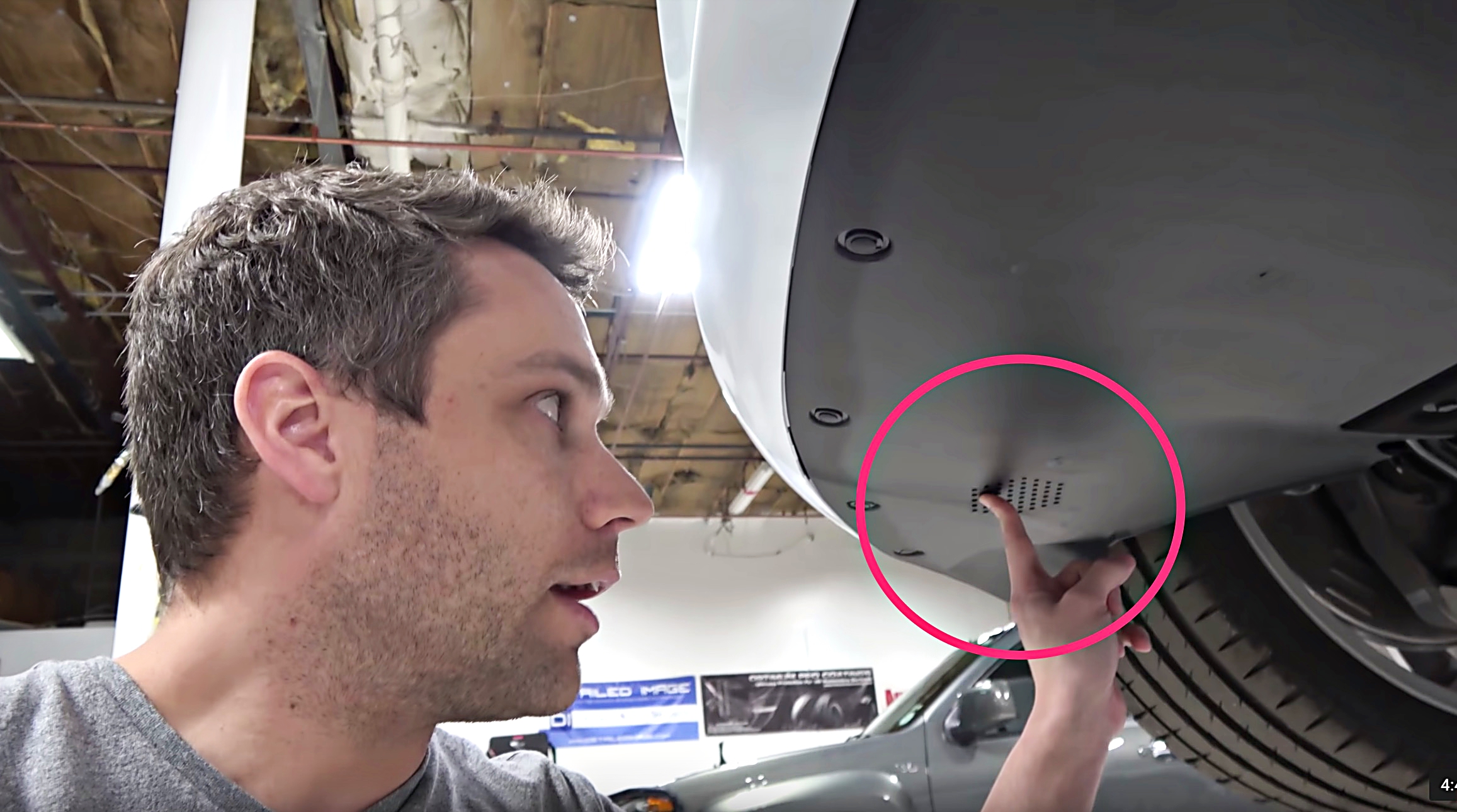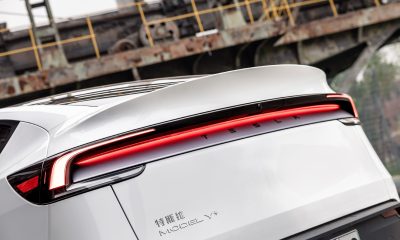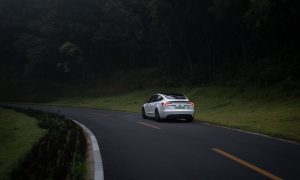

News
Tesla Model 3 spotted with “pedestrian noise maker” ahead of NHTSA mandate
It looks like Tesla may have already begun getting its newer manufactured vehicles ready for compliance with an upcoming National Highway Traffic Safety Administration (NHTSA) requirement for electric and hybrid electric vehicles to make noise when traveling at slow speeds. In a video posted by Tesla community’s resident DIY expert, Erik, or otherwise known as DÆrik from his YouTube channel, the undercarriage panel of his Performance Model 3 has what appears to be a speaker grill – the front paneling is adorned with a series of holes in a hexagonal shape. Once the paneling is removed, three mounting points are revealed to be molded into the same area, hinting at a future device to come.
The video was made in response to inquiries about a photo of the Tesla’s undercarriage posted to Erik’s Instagram account where someone noted the series of holes in the plastic panel below the front bumper. Tesla’s parts catalog doesn’t currently show the grill cutout, but As Erik notes in the video, he found a Model S diagram three years ago showing a layout including a future noise maker labeled “Speaker Pedestrian Noise”.
We’ve reached out to Tesla for comment about the new “speaker grill” found in the underside of the Model 3 and will provide updates as we receive them.
https://www.instagram.com/p/BsYwz0ygTB5/
Blind pedestrians rely heavily on auditory clues to anticipate traffic patterns and know a vehicle is near, and that means the quiet nature of electric and hybrid vehicles at low speeds may pose a greater danger to them than traditional internal combustion engine (ICE) vehicles. Bicyclists and other pedestrians also utilize usual car sounds as part of their personal safety awareness, so there’s a population of travelers that could be significantly impacted by the influx of EV/HEV vehicles on the roads. The potential danger has not gone unnoticed by those in charge of public safety.
This concern was elevated to the federal level by the NHTSA, and the eventual result was a 2010 law (Pedestrian Safety Enhancement Act of 2010) requiring electric and hybrid vehicle manufacturers to install devices which emit noise while traveling slower than about 19 mph. Higher speeds have tire and wind noise that’s sufficient for pedestrian needs. The implementation rules were finalized in February last year, and manufacturers have until September 1, 2020, to be fully compliant, with half of the vehicles equipped by September 1, 2019.
While the proposal may not be popular with all parties involved, the NHTSA points to its October 2009 report entitled “Research on Quieter Cars and the Safety of Blind Pedestrians, a Report to Congress” as a primary basis for its rulemaking. In the report, the agency found an increased rate of accidents involving pedestrians with hybrid-electric vehicles compared to ICE vehicles in roadways and zones with low-speed limits, during the type of weather or any time of day. By implementing the rules as passed, the NHTSA expects to prevent 2,400 injuries and reduce the $250-$320 million costs which result annually due to limited ability to detect quiet EVs/HEVs.
POPULAR: DIY Tesla Model S Pedestrian Alert: “Horn” for the Oblivious
Another coming requirement is that the noise emitted must be identifiable as a vehicle, a limitation that will likely only inspire creativity. If manufacturers want to take a fun route with the noise options, i.e, license the Jetson family’s flying car sound from Hanna Barbara as suggested by Erik, they’ll have to make sure it’s consistent among their vehicles – or at least consistent among package options. Also, drivers cannot be allowed to modify the sound themselves.
Manufacturers are free to modify the sounds from the factory end, though, an option Tesla’s CEO Elon Musk has previously capitalized on for other noise-centric features in the electric car company’s vehicles. However, letting drivers determine their car’s noise via app or button push is still in the air. The NHTSA will publish a separate document at a later date to determine whether driver-selectable sounds are a good idea, or at least compliant with the purpose of the law.
Watch the video below to see Erik’s Model 3 inspection:
Elon Musk
Elon Musk confirms Grok 4 launch on July 9 with livestream event
The rollout will be accompanied by a livestream at 8 p.m. Pacific Time.

Elon Musk has officially confirmed that Grok 4, the latest version of xAI’s large language model, will launch on July 9. The rollout will be accompanied by a livestream at 8 p.m. Pacific Time, hosted on xAI’s official account on X.
xAI goes straight to Grok 4
Back in May, leaks indicated that xAI was getting ready to ship Grok 3.5. Considering Musk’s recent comments, however, it appears that the artificial intelligence startup would be focusing on the large language model’s fourth iteration instead. As noted in a Financial Express report, users on X have sighted references to Grok 4 in the lead up to the update’s launch, such as “grok-4-prod-mimic” and “Grok 4 Code.”
Musk’s Grok 4 announcement comes as AI competition intensifies between major players including OpenAI, Google, and xAI. With Musk’s Colossus supercomputer fully operational in Memphis, xAI appears to be accelerating its AI product roadmap.
Musk pushes Grok toward political neutrality
Grok 4’s launch also follows a recent controversy involving political bias, as noted in a CNN report. Last week, Grok responded to a user on X stating that political violence in the U.S. since 2016 had come more from the political right than the left. The chatbot noted in a later reply that its answer was based on information from sources like Reuters, the Journal of Democracy, and University of Maryland studies.
Musk stated that Grok’s response was a “major fail.” “Major fail, as this is objectively false. Grok is parroting legacy media. Working on it,” he wrote in a post on X. By the end of June, Musk noted that he was “grinding all night with the xAI team” and that they were making “good progress.” He also stated that the model “Will be called Grok 4. Release just after July 4th. Needs one more big run for a specialized coding model.”
News
Tesla opens massive solar Supercharger station in California
The Supercharger opened to customers ahead of Fourth of July weekend, while Tesla continues phase two of construction on the site.

Tesla has officially launched the first several Supercharging posts at a massive station in California, notably including solar canopies and grid-scale batteries to offer completely renewable charging.
Last week, Tesla announced on X that it opened the first 84 Supercharger stalls of a planned 168-stall station in Lost Hills, California. Additionally, the massive Supercharger project features 11MW of solar canopies and 10 Megapack batteries for off-grid charging powered entirely by solar energy.
Tesla completed the first phase of the project just days ahead of the busy Fourth of July holiday weekend, adding that initial construction took just eight months. In addition to the remaining charging stalls, Tesla says it’s building a set of lounge areas, renderings of which can be seen below alongside current photos of the site.
Notably, the site also includes V4 charging posts for the company’s latest available charging speeds, and it’s located near the busy junction between I-5 and Highway 46 in Kern County.
“Thank you [Kern County] and [PG&E] for collaboration and approvals,” Tesla wrote in a follow-up post.

Credit: Tesla Charging | X

Credit: Tesla Charging | X

Credit: Tesla Charging | X

Credit: Tesla Charging | X
Tesla Supercharger Maps for North America, Europe, and Asia pic.twitter.com/0U5r0XRPyo
— TESLARATI (@Teslarati) July 2, 2025
READ MORE ON TESLA SUPERCHARGERS: Tesla launches ultra-fast V4 Superchargers in China for the first time
Testing at the LA Diner, plus Musk update on potential Tesla solar Gigafactory
The huge Tesla Supercharger station completed phase one of construction fairly quickly, especially given how long Tesla has been working on its unique Los Angeles diner, drive-in, and Supercharger location. Still, the company was seen performing some testing at the nearly-completed charging station earlier this month, and will reportedly be holding a job fair.
Elon Musk also responded on Monday morning to a post on X, suggesting that Tesla is “thinking about” building a U.S.-based solar Gigafactory in order to help support increased power needs with AI growth, and to bolster domestic solar production.
Tesla is building a new UFO-inspired Supercharger in the heart of Alien country
News
Tesla driver walks away from major accident with minor injuries
The driver sustained only minor injuries, and the exact cause of the crash remains under investigation.

The driver of a Tesla Model Y survived and walked away from a harrowing accident on Monday in California, only sustaining minor injuries despite the vehicle being impaled by a guardrail.
On Monday morning around 4:34 a.m., the Los Banos division of the California Highway Patrol (CHP) responded to the accident on I-5 near Panoche Road, involving a 23-year-old in a Tesla Model Y. According to a post on social media, the driver veered off the road for unknown reasons in the northbound lane, before crashing directly into the guardrail and impaling the vehicle.
You can read the full message and photos from Los Banos CHP below, as were shared in a Facebook post on Monday afternoon.
This morning a Tesla model y was traveling in the #1 northbound lane of I-5 north of Panoche Rd. For unknown reasons driver allowed V-1 to veer off the roadway, travel through a dirt center divide, and crashed into the fixed metal guardrail. Lucky for the driver he only sustained minor injuries and was able to walk away. Driving a vehicle requires 100% attention to the road. Avoid distractions and focus on driving.

Credit: CHP Los Banos (via Facebook)

Credit: CHP Los Banos (via Facebook)

Credit: CHP Los Banos (via Facebook)
In a statement to SFGate, CHP officer Myles Anderson said that the driver only sustained minor injuries, while no arrests are made and drugs and alcohol are not suspected to have been involved. The report also notes that Tesla’s “cruise control and lane assistance features” were activated, according to Anderson. However, it’s not entirely clear if this is referring to Supervised Full Self-Driving (FSD), or to the cruise control and lane assist features baked into Autopilot.
At the time of writing, CHP has not yet responded to Teslarati’s request for clarification and additional details on the matter.
Tesla Crash Safety Ratings across its lineup: pic.twitter.com/ny30R7ceji
— TESLARATI (@Teslarati) July 1, 2025
READ MORE ON TESLA SAFETY: Tesla rolls out crucial new safety feature aimed at saving children
The news comes after Tesla has touted its vehicles as incredibly safe for many years. In December, for example, the company highlighted receiving top safety scores from regulators on four different continents throughout the world, including from the National Highway Traffic Safety Administration (NHTSA) and the Insurance Institute of Highway Safety (IIHS) in the U.S.
Tesla has also listed the goal of making its vehicles the safest on the road throughout the years, both in the overall design of its vehicles and in its Autopilot and Full Self-Driving (FSD) programs.
Tesla Model 3 ranks as the safest new car in Europe for 2025, per Euro NCAP tests
-

 Elon Musk1 week ago
Elon Musk1 week agoTesla investors will be shocked by Jim Cramer’s latest assessment
-

 News2 weeks ago
News2 weeks agoTesla Robotaxi’s biggest challenge seems to be this one thing
-

 News2 weeks ago
News2 weeks agoWatch the first true Tesla Robotaxi intervention by safety monitor
-

 Elon Musk2 weeks ago
Elon Musk2 weeks agoA Tesla just delivered itself to a customer autonomously, Elon Musk confirms
-

 News2 weeks ago
News2 weeks agoTesla Robotaxi rollout proves that Elon Musk still delivers, even if it’s late
-

 Elon Musk2 weeks ago
Elon Musk2 weeks agoxAI welcomes Memphis pollution results, environmental groups push back
-

 Elon Musk2 weeks ago
Elon Musk2 weeks agoElon Musk commends Tesla team on successful Robotaxi launch
-

 Elon Musk2 weeks ago
Elon Musk2 weeks agoElon Musk confirms Tesla Optimus V3 already uses Grok voice AI


















